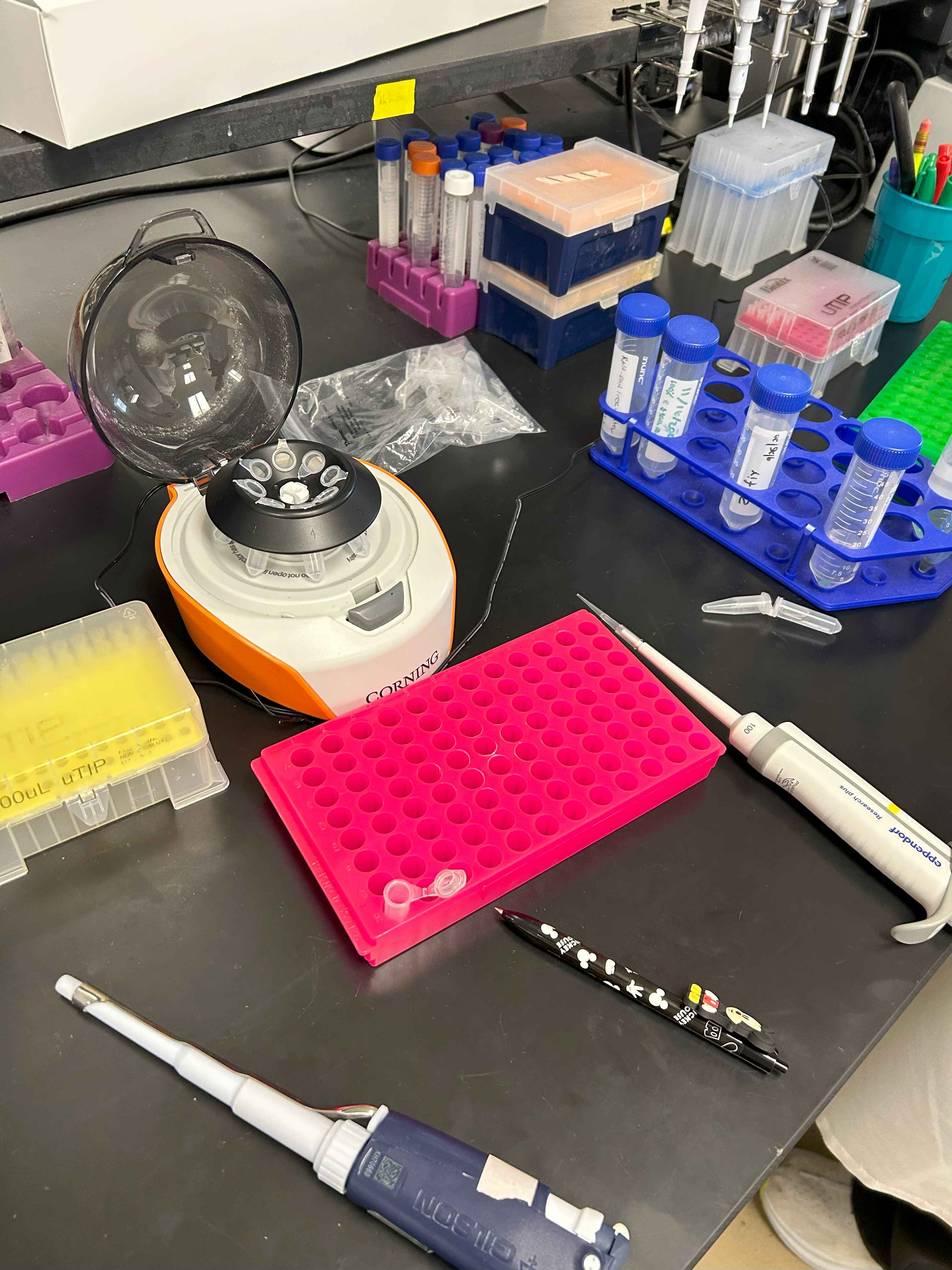TrUE Scholars
As part of the Nutrition, Inflammation, and Obesity Research lab underneath Dr. Naima Moustaid-Moussa (PI) and Dr. Yujiao Zu (Co-PI), I have learned a lot about the fascinating field of research. To begin, this is my first year of research, and first time working in a laboratory setting. As such, I was required to complete my online training during the summer for biological safety, bloodborne pathogens, and laboratory safety. When I began working in the research lab in early fall, I started off with my pipetting training. Pipetting is a crucial skill to have in the NIOR lab, as even small dilute concentrations can have a major impact on the desired results. After the pipetting training was completed, I then put my skills to work by completing the Bradford Assay, which tests how well the concentrations of various samples compare to one another. The more accurate one's Bradford Assay, the more straight the curve will be, indicating an R2 value closer to 1. I conducted the Bradford Assay a total of 4 times, in which my first R2 value was 0.96, and then my second was 0.996, third was 0.997, and fourth was finally 0.999. I was satisfied with my results at the end of my Bradford Assay protocols, and was able to move onto working on a lab project. My project involves using C. elegans worms and determining the effect of tart cherry supplements on their lifespan. However, the twist is that there are different strains of the worms, in which some of the worms have a gene that is indicative of Alzheimer's disease found in humans. That is the specific strain of C. elegans that I will be working on in the future. While I was learning more about my research project, Dr. Yujiao Zu taught me about how Alzheimer's occurs- from the tau and aggregating proteins that can block neuron pathways in the brain. This causes the symptoms of Alzheimer's: loss of movement, memory, difficulty thinking and seeing, deterioration in functional and intellectual skills, delusions, etc. This was my most impactful revelation or my “Oh! That's cool!” moment during my research lab. From here on out, I have been very interested in determining how the gene that expresses Alzheimer's can be minimized with the effects of a nutritional complement such as tart cherry.

One challenge that I anticipate that I will have to overcome is my inexperience with
different laboratory techniques and methods, such as RNA extraction, centrifuging,
data analysis, chunking, etc. This also leads to the further challenge of creating
an effective procedure and method in order to test my question: How does tart cherry
affect the gene expression of Alzheimer's in specific C. elegans worms? Does it maximize
or minimize the levels of gene expression that express Alzheimer's? These are essential
questions that I will later be analyzing and testing over, as I will begin to create
my case presentation that will be presented at the 2024 URS Conference.
Thankfully, with the help of my mentors: Dr. Naima, Dr. Yujiao, and senior undergraduate
student Tasnim, I have been able to narrow down the focus of my research into something
more manageable. Originally the C. elegans project was fully run by undergraduate
students about 2-3 years ago. However, most of the undergraduate students who worked
on the C. elegans project have already graduated, leaving just Tasnim behind. Dr.
Naima and Dr. Yujiao decided that it would be best for me and Tasnim to split our
project into two main research cases. Tasnim would dive deeper into the Life Span
analysis of the C. elegans worms using the NemaLife program and machine, where I would
investigate further into the gene expression analysis using RNA extraction protocol.
Dr. Yujiao and Tasnim granted me access to the NemaLife program, so that I can view
all of the worms that we have on record so far. I also have permission to conduct
RNA extraction using the Zymo Research kits. However, in the case of the C. elegans,
I will be using a much smaller kit in order to more accurately determine the gene
expression levels. This is due to the very small size of C. elegans and their RNA.
My overall experience in the lab has been very exciting. I have met a diverse range
of new people such as: new undergraduate students such as myself, upperclassmen undergraduate
students, graduate students (TAs), and Doctors (PhD). Everyone has been very kind
and welcoming to me, as I am just a beginner who is starting to develop their research
journey. It turns out that Tasnim- the older undergraduate student that I am working
alongside with- was my old CA from last year! And one of the graduate students- Sadique-
goes to my local Mosque for Friday prayers. It's a small world! In addition, my PI-
Dr. Naima Moustaid-Moussa has multiple connections to the medical school at Texas
Tech, as her daughter completed her medical school at the HSC. My field of interest
is to one day work in the medical field and perform research on the fields of oncology
and neurology. Interestingly enough, the field of nutrition plays a huge role in the
development of cancers and brain diseases such as Alzheimer's. This can be seen through
the impacts of disorders such as diabetes and obesity.
